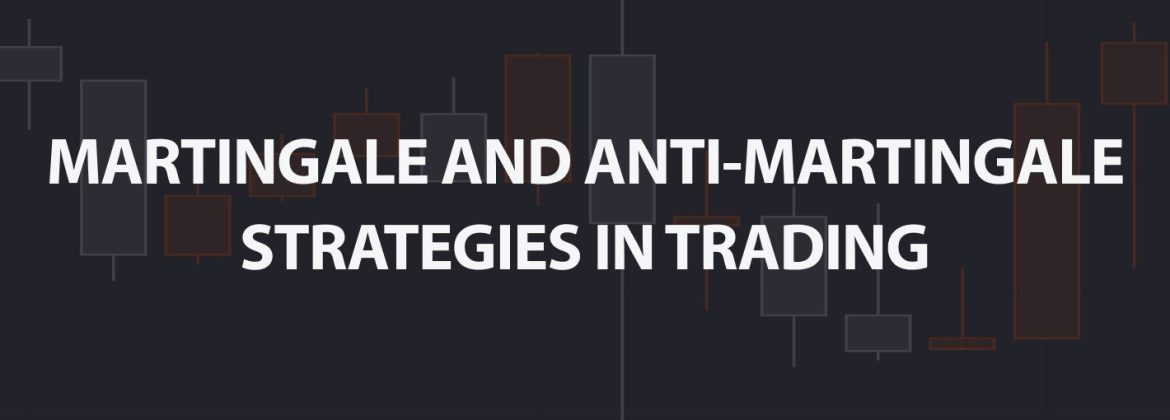Book Your Classes Today!
Martingale and Anti-Martingale Strategies in Trading
- Home
- Martingale and Anti-Martingale Strategies in Trading

Martingale and Anti-Martingale trading strategies have been employed by traders for decades. They offer different approaches to managing risk and increasing profit potential. This FXOpen article explores both techniques and highlights their benefits and drawbacks.
What Is Martingale Trading?
The Martingale strategy, named in honour of John Henry Martindale, the owner of a casino in London, who applied this approach in the 1700s, found its application in trading in the middle of the 20th century. It’s based on the assumption that a trader can’t always lose. Therefore, a trader increases the size of a trade every time they lose. Its essence is simple: after each unprofitable trade, double your position size, hoping to eventually recover your losses and make a profit.
How Martingale Works
The basic Martingale is a model in which a person starts trading with a given position size. Then, they double the size of the trade after losing and can return to the original position size only after a profitable trade.
Let’s have a look at how this doubling-down technique works. Imagine a person has an initial balance of £10,000. In the first trade, they risk 2% of their initial balance.
Trade
Initial Balance
Martingale Risk %
Martingale Balance
0
£10,000.00
1
2%
£10,200.00
2
2%
£9,996.00
3
4%
£9,596.16
4
8%
£10,363.85
The trader lost in the second trade, doubled the position size, and lost in the third trade. The trader then doubled the position size again and got a winning trade that not only covered the loss but also added $363.85 on top of the last profitable trade. After the winning trade, the trader could go back to the original position size.
Pros and Cons of Martingale
There are both benefits and drawbacks of this trading method.
Pros:
It offers the ability to recover profits quickly
It is easy to understand and apply this method
Cons:
There’s a high risk of significant losses
It requires a large capital reserve
There’s no guarantee of success
On the one hand, no matter how many losing trades a trader faces, on the next winning trade, they will compensate for all the losses they had since their last success, plus get a profit equal to the original trade size.
On the other hand, this approach can lead to significant losses if the losing streak doesn’t end. If you have many losses in a row, and you double your position after each loss, at some point, it will be impossible to continue because your account balance will be insufficient.
What Is Anti-Martingale Trading?
Anti-Martingale money management strategy uses the opposite approach. It involves halving the size of each position after a loss and doubling it after a win. This method aims to make profits during winning periods.
How Anti-Martingale Works
For simplicity, let’s go back to the example we took for the Martingale approach. Assume that the person still has £10,000. They risk 2% of the balance per trade, and if they win, they increase the percentage, but if they fall, they cut it.
Trade
Initial Balance
Martingale Risk %
Martingale Balance
0
£10,000.00
1
2%
£10,200.00
2
4%
£9,792.00
3
2%
£9,596.16
4
1%
£9,612.09
So, the trader succeeded in the first trade, doubled their position size, and lost in the second trade. Then, the trader halved their position size and, on the next trade, lost 2% of their balance. In the fourth trade, they risked only 1% of the balance but succeeded.
If we compare the results of both strategies based on four trades, it’s clear that the Martingale approach may bring faster rewards. However, it is worth noting that the number of losing trades may be greater than in our examples, which will deplete the trader’s balance before they manage to make any money.
Pros and Cons of Anti-Martingale
Overall, this approach allows you to maximise profits during good times and minimise losses when luck is not on your side. Let’s see its advantages and disadvantages.
Pros:
It helps minimise risk during losing streaks
It allows you to capitalise on winning streaks
It can be less stressful than Martingale
Cons:
There’s a potential for missed opportunities (if there are rapid market shifts)
It can be challenging to determine the appropriate position size
It requires discipline and strong management skills
The Anti-Martingale strategy is considered a less risky approach because it reduces the risk per trade and ultimately reduces the risk of losing money. It assumes that you take advantage during expansive growth, and it is considered a more practical and logical money-management model.
Additionally, there are Anti-Martingale calculators designed to help determine position sizes based on risk tolerance and the percentage of profits to reinvest. The calculator usually suggests increasing the position size after a winning trade and decreasing it after a losing one, which corresponds to the principles of the strategy.
However, similar to the Martingale, the Anti-Martingale approach requires a large amount of money to cover losses. Also, while the Anti-Martingale can work well in momentum-driven markets, the markets can quickly turn against traders, resulting in significant losses.
Comparing Martingale and Anti-Martingale Trading Strategies
The key difference between these strategies is their opposite approaches to risk and money management. Martingale involves doubling the position after a loss with the expectation of a profit return, which can lead to significant losses. Anti-Martingale, in contrast, involves increasing the position after the success to take advantage of winning streaks and reducing the position size during losing streaks, emphasising risk aversion.
Is it worth combining Martingale and Anti-Martingale techniques? As these are opposite approaches, the theory states a trader should choose the one that meets their requirements. Start by defining your risk tolerance and trading objectives, and then adapt your strategy to changing market conditions. By doing this, you will understand whether it’s more important for you to significantly increase potential profits or reduce potential risks.
You can open an FXOpen account to test both strategies and better understand which one works for you. To choose assets wisely, consider using the TickTrader platform for technical analysis before you start trading. Advanced charts and analytics tools can be of great help.
Considerations
Both strategies may seem very sound, and people often have the misconception that after a series of losing trades, the chances of winning increase. However, mathematically, markets work randomly, and the probability of a profitable trade is completely independent of how many profitable or unprofitable trades there have been up to that point. It is like when you flip a coin; no matter how many times you get heads, the chances of getting tails on the next flip are always 50/50.
Final Thoughts
Although both strategies have their own benefits and drawbacks, it’s vital to determine the most important aspects for yourself as there is no one-size-fits-all approach. Remember, successful trading is not just about strategy; it’s also about discipline, patience, and continuous learning.

Leave A Comment